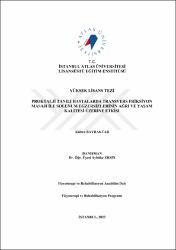Proktalji tanılı hastalarda transvers friksiyon masajı ile solunum egzersizlerinin ağrı ve yaşam kalitesi üzerine etkisi = The effects of transverse fraction massage and breathing exercise on pain and quality of life in patients with proctalgia
Künye
Bayraktar, K. (2023). Proktalji tanılı hastalarda transvers friksiyon masajı ile solunum egzersizlerinin ağrı ve yaşam kalitesi üzerine etkisi. (Yüksek lisans tezi, İstanbul Atlas Üniversitesi, İstanbul). Erişim adresi https://hdl.handle.net/20.500.12900/147Özet
Proktalji, gece veya gündüz herhangi bir sebep olmadan anal bölgede birkaç saniyeden dakikalara uzayan ani, batıcı bir ağrı olarak tanımlanabilir. Şikayetlerde farklılıklar olması nedeniyle net bir tanımı yapılamamıştır ve patofizyolojisi tam olarak anlaşılamayan bir rahatsızlıktır. Şikayetlerin fizyoterapi ile azaltılması mümkündür. Bu çalışma, proktalji tanısı almış kişilerde transvers friksiyon masajı (TFM) ve solunum gevşeme egzersizlerinin semptom, ağrı ve yaşam kalitelerindeki değişimlerini belirlemek amacıyla yapılmıştır. Anorektal ağrı şikayetiyle tıbbi desteğe başvurup proktalji teşhisi alan 18-60 yaş arasındaki hastalar çalışmaya dahil edilmiştir. Dahil edilenlerden rektal cerrahi öyküsü, hemoroidi veya nörolojik rahatsızlığı olanlar çalışma dışı bırakılıp, çalışma 10 hasta ile tamamlanmıştır. Hastalara, 4 hafta boyunca haftada 2 gün toplamda 8 seans olacak şekilde Eksternal anal sfinktere (EAS) TFM uygulanmıştır. Buna ek olarak hastalara solunum gevşeme egzersizleri 4 hafta boyunca ev programı olarak verilmiştir. Tedavi öncesi ve tedavi bitiminde aynı fizyoterapist tarafından hastalardaki hassasiyet ve spazm dijital rektal muayene ile değerlendirilirken; ağrı şiddeti Görsel Analog Ölçeği (VAS) ile ölçülüp, semptomlar Öz Değerlendirme Sağlık Profili 2 (Measure Yourself Medical Outcome Profile 2 (TMYMOP2)) ve yaşam kalitesi Notthingam Sağlık Profili (NHP) ile değerlendirilmiştir. Çalışmadaki hastaların yaş ortalaması 38,10±11,160'tır. Tedavi bitimi değerlendirmeleri yapılan hastaların ağrı şiddetinde ve semptomlarında azalma görülmüş (p<0,05) yaşam kalitesinde artma olduğu belirlenmiştir (p=0,05). Ancak yaşam kalitesi alt değişkenlerinden sosyal izolasyon, fiziksel aktivite ve enerji kategorilerinde istatiksel olarak anlamlı bir değişme saptanmamıştır (p>0,05). Sonuç olarak, Proktalji tanısı konmuş kişilerde EAS'a uygulanan TFM tekniği ve solunum gevşeme egzersizlerinin fizyoterapistlerin hastalara uygulayabilecekleri risksiz, etkili ve kolay bir yöntem olduğu görülmektedir. Proctalgia can be defined as a sudden, stabbing pain lasting from a few seconds to minutes in the anal region without any reason, day or night. Due to the differences in complaints, a clear definition could not be made and it is a disorder whose pathophysiology is not fully understood. Complaints can be reduced with physiotherapy. This study was carried out to determine the changes in symptoms, pain and quality of life of transverse friction massage (TFM) and respiratory relaxation exercises in people with proctalgia diagnosis. Patients between the ages of 18-60 who applied to medical support with the complaint of anorectal pain and were diagnosed with proctalgia were included in the study. Among those included, those with a history of rectal surgery, hemorrhoids or neurological disorders were excluded from the study, and the study was completed with 10 patients. TFM was applied to the external anal sphincter (EAS) in a total of 8 sessions, 2 days a week for 4 weeks. In addition, respiratory relaxation exercises were given to the patients as a home program for 4 weeks. While sensitivity and spasm in patients are evaluated by digital rectal examination by the same physiotherapist before and at the end of the treatment; pain intensity was measured with the Visual Analog Scale (VAS), symptoms were evaluated with the Turkish version of Measure Yourself Medical Outcome Profile 2 (TMYMOP2) and quality of life was evaluated with the Nottingam Health Profile (NHP). The mean age of the patients in the study was 38.10±11.160. It was determined that the pain severity and symptoms of the patients who were evaluated at the end of the treatment decreased (p<0.05) and that there was an increase in the quality of life (p=0.05). However, no statistically significant change was found in the categories of social isolation, physical activity and energy, which are sub-variables of quality of life (p>0.05). As a result, it is seen that the TFM technique and respiratory relaxation exercises applied to EAS in people diagnosed with proctalgia are a risk-free, effective and easy method that physiotherapists can apply to patients.

















